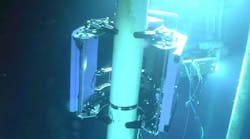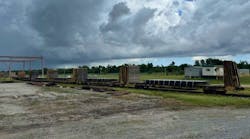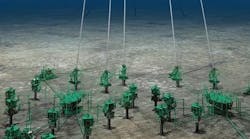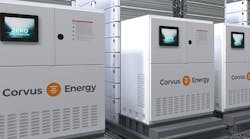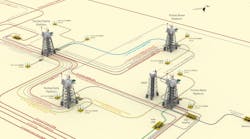What keeps getting better and better, yet cheaper and cheaper? Computer chips, yes, but also seismic data. The current speculative and multi-client business models (see April and May 2000 issues) require volume sales of a single high quality product (like computer chips) for the seismic companies to make a profit.
With continued industry consolidation, the number of potential customers is dropping and profit margins are razor thin. New speculative data currently is selling at about half its unit price of two years ago. This business model is failing.
The volume of sales is insufficient to meet the contractor's profit hurdle. So, the unit cost of data must rise, seismic contractors must merge, or the seismic business model must change. Seismic contractors have been in a squeeze for years, yet their customers continue to demand more data, of better quality, for a continually decreasing cost. The bottom has been found, and some users expect that costs will have to rise in the near future.
Garbage in, garbage out
Oil and gas producers face a classic computer dilemma: garbage in, garbage out. Most speculative seismic surveys, whether 2D or 3D, are processed twice: once by the acquisition company and then again by the oil and gas producer that purchased a data license.
The second processing is usually done by a third-party company rather than by the acquisition company, because oil company geophysicists want to "tweak the data," according to their corporate views and personal preferences. The acquisition company must handle speculative data processing more generically because of the survey's quick turn-around nature. The key is good initial acquisition.
This sets up a quandary for oil and gas producers. They can accept spec data, rework it, and make do when it does not clearly image their prospects, or, they can shoot proprietary surveys and get exactly what they want. Either way they will pay some price.
If the seismic companies must lower spec data quality to control costs, the possibility of improving the data by reprocessing will fail to meet oil and gas producer's needs. If seismic contractors continue to produce higher quality data sets, the price for data collection must rise to cover the full cost of acquisition. You get what you pay for.
Third party aggregation, checking of data
One of the limits to international licensing is the cost and expense of reviewing, acquiring, and analyzing data from remote lands. In the recently announced offshore Gabon licensing round, a new approach is being tried. Schlumberger's IndigoPool is providing secure access to proprietary Gabonese data for online browsing and in-depth analysis by clients. The company has organized and quality checked data, and developed both virtual and physical data rooms as part of a bundled service for the government. This experiment may open more activity in international licensing by drawing smaller independents into foreign oil plays, and more companies into aggregating data.
Time-dependent process and virtual reality
A key trend at the American Association of Petroleum Geologists Convention held in April in New Orleans was the expanded use of video loops and animation in presentations to illustrate time-dependent geological processes. Of special note are two new virtual reality (VR) tools exhibited:
- Projection system: Fakespace and Phillips presented the conCAVEtrademark, a quarter-sphere with flat base using a single color projector. The unit is designed for a small interpretation team in a normal office setting. Seismitariumtrademark software maps 3D data to the volume and shape of the small curved format.
- Multiple attribute volumes: Magic Earth is commercializing VR software developed at Texaco. GeoProbetrademark is capable of multiple attribute volume displays within a 3D survey, which can be independently manipulated. The tool is designed to help geoscientists quickly identify and characterize volumetric anomalies. Mike Zeitlin, formerly Texaco's VR champion, leads the new company.
Exploration
- Tunisian survey: Fugro-Geoteam AS is collecting a regional 2D non-exclusive survey (PS2000) for ETAP over Tunisia's Pelagian Shelf. Four blocks in the Mediterranean Sea: E2, E3, E4, and E5 will be covered. The survey collected will be 3,500 km long when completed, and will tie 20 wells that penetrate the Tertiary and Mesozoic sections. Archival seismic is unreliable below two seconds, so the new survey is designed to: (1) Image mid-Cretaceous and earlier unconformities; (2) Define the structural pattern into the Mesozoic section; and (3) Tie the maximum number of wells for control. The Geco Baltic will collect eight-second records using 6,000 meter streamers.
- Eastern Canada shoot: TGS-NOPEC began a 12,000 km non-exclusive 2D survey off Eastern Canada. The "Tail of the Bank" survey extends the company's deepwater coverage around the Newfoundland Grand Banks covering three basins: Tail of the Bank, South Wales and Carson. It is being recorded by Schlumberger's M/V Akademik Shatskiy using 8,000 m streamers. The vessel will gather 14-second records at 4 ms sampling to yield 106-fold density.
- North Sea 4C: Schlumberger Oilfield Services announced the completion of a nonexclusive multi-component (4C) survey over Chestnut field in the North Sea. The survey covers 126 sq km in UK blocks 22/1 and 22/2. "We know from the (earlier) Alba survey that the converted wave data gives excellent illumination of the Eocene sand reservoirs in this area," commented John Close, Region Vice President for Schlumberger Reservoir Evaluation Seismic. Two vessels, Geco Bluefin and Geco Angler, acquired the data.
Technology
- VR - curvy and close: Virtual reality imaging has been limited by either flat screens requiring direct frontal viewing or forward image projection which throws shadows. Now a new screen system overcomes the restrictions of both processes with: (1) A curved screen allowing peripheral vision use; (2) Backlighted projection allowing at-screen interpretation. "This is a technology that geoscientists have been waiting for. The curved screen configuration is popular among explorationists because of its wrap-around immersion, but the shadows cast on the image have caused problems when researchers walk in front of the image," said Chris Clover, President & CEO of MechDyne Corporation. Large geometric corrections are required for this type of projection. Special electronics were developed to accommodate the high demand these calculations place on the projection system.
- Quality control: At this year's OTC, PGS Exploration demonstrated a new quality control system, holoSEIStrademark, which will be used to check illumination coverage and other survey attributes. The system uses a two-sided worktable display system with a "wand" interface (similar to a pen). It will be shore-based, but support marine acquisition projects.
